Unit 3 Where did you go?单元教案
文档属性
| 名称 | Unit 3 Where did you go?单元教案 | 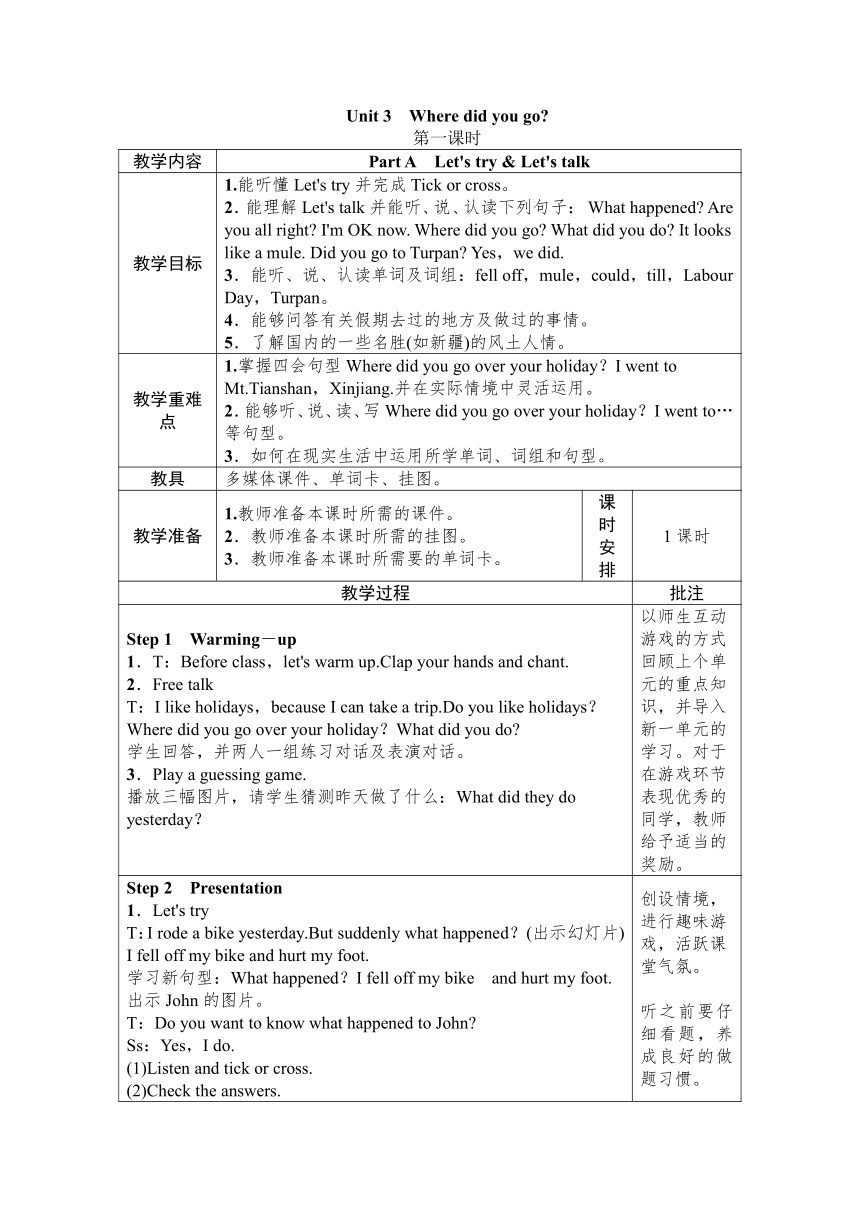 | |
| 格式 | zip | ||
| 文件大小 | 17.8KB | ||
| 资源类型 | 教案 | ||
| 版本资源 | 人教版(PEP) | ||
| 科目 | 英语 | ||
| 更新时间 | 2020-04-30 15:58:47 | ||
图片预览

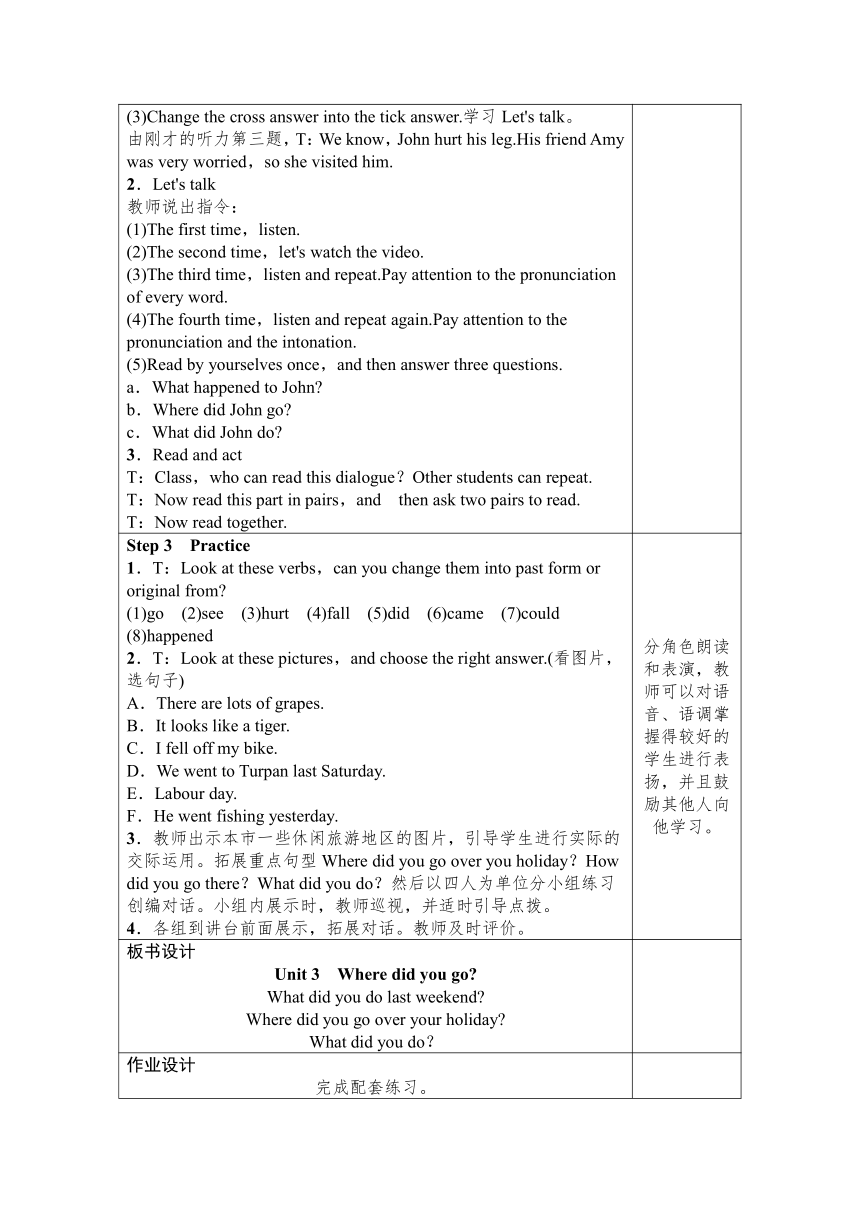
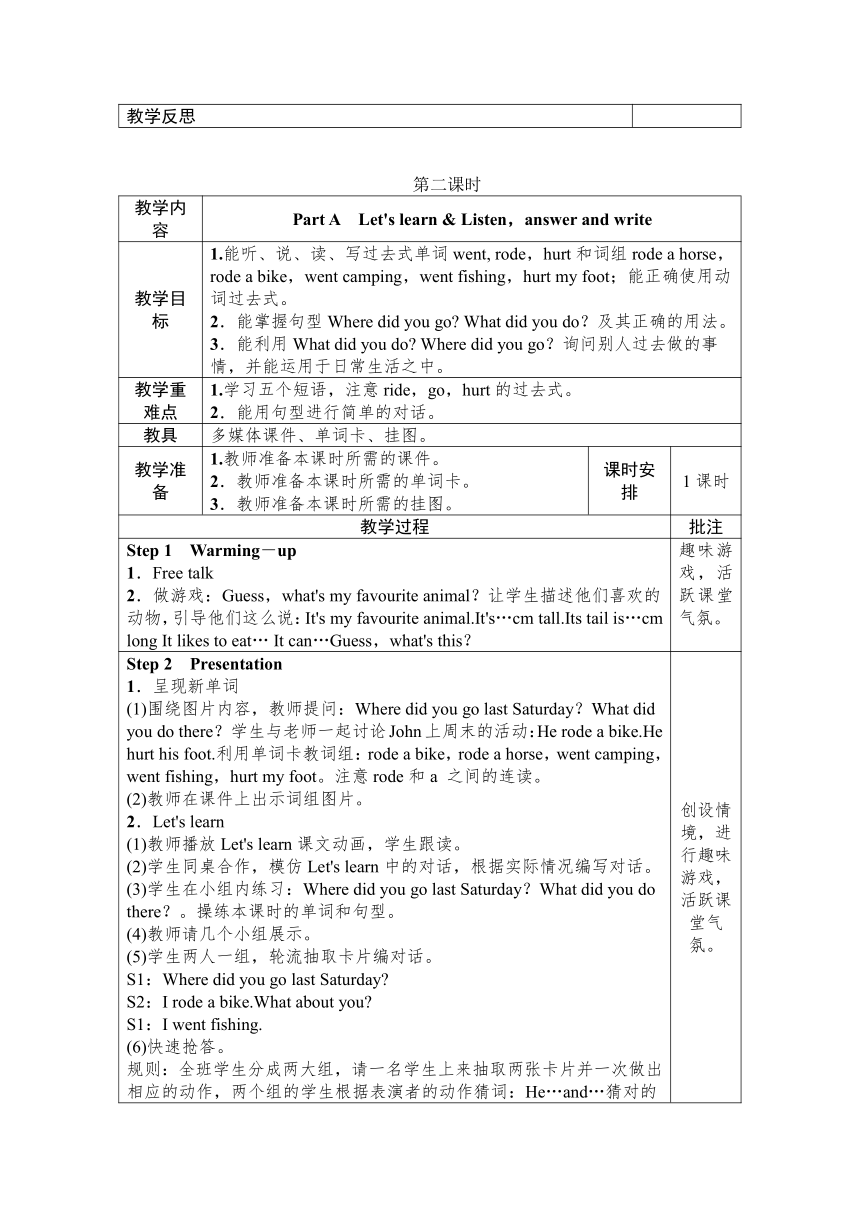
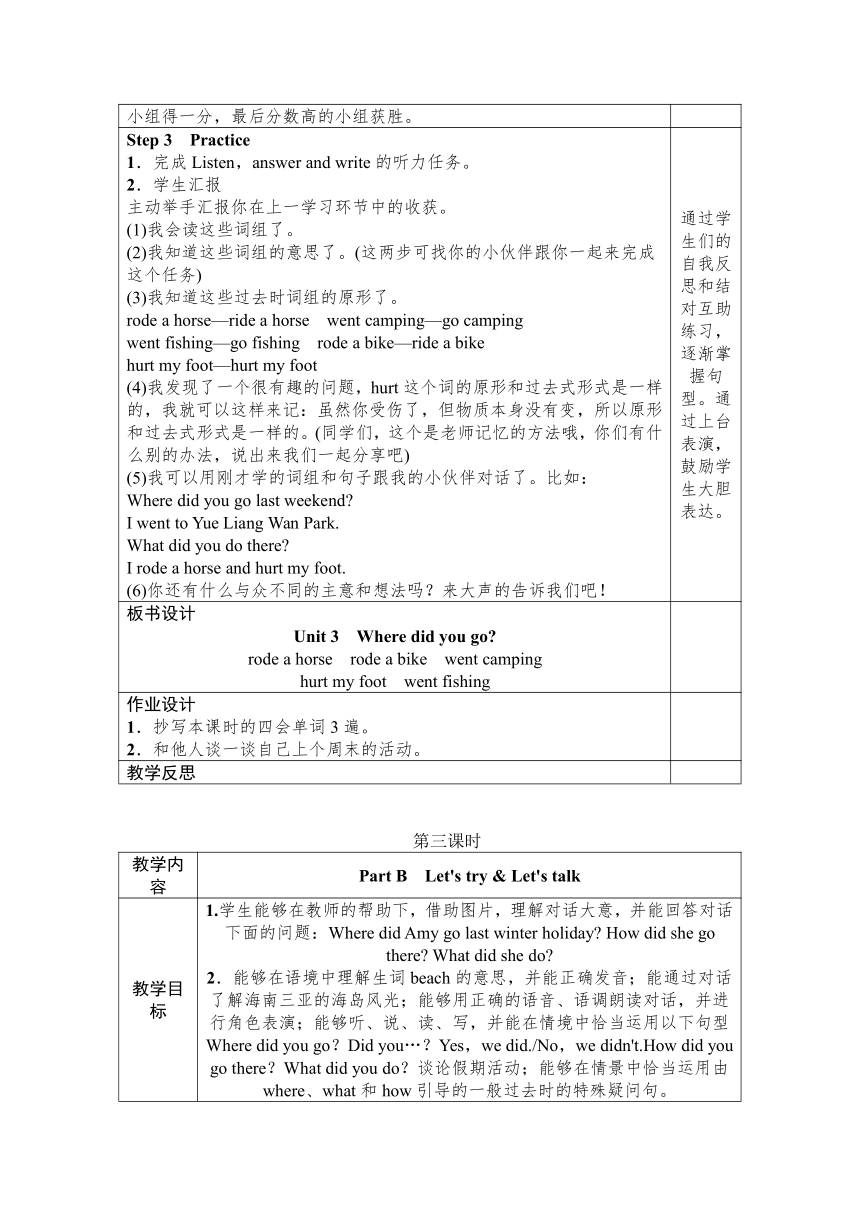
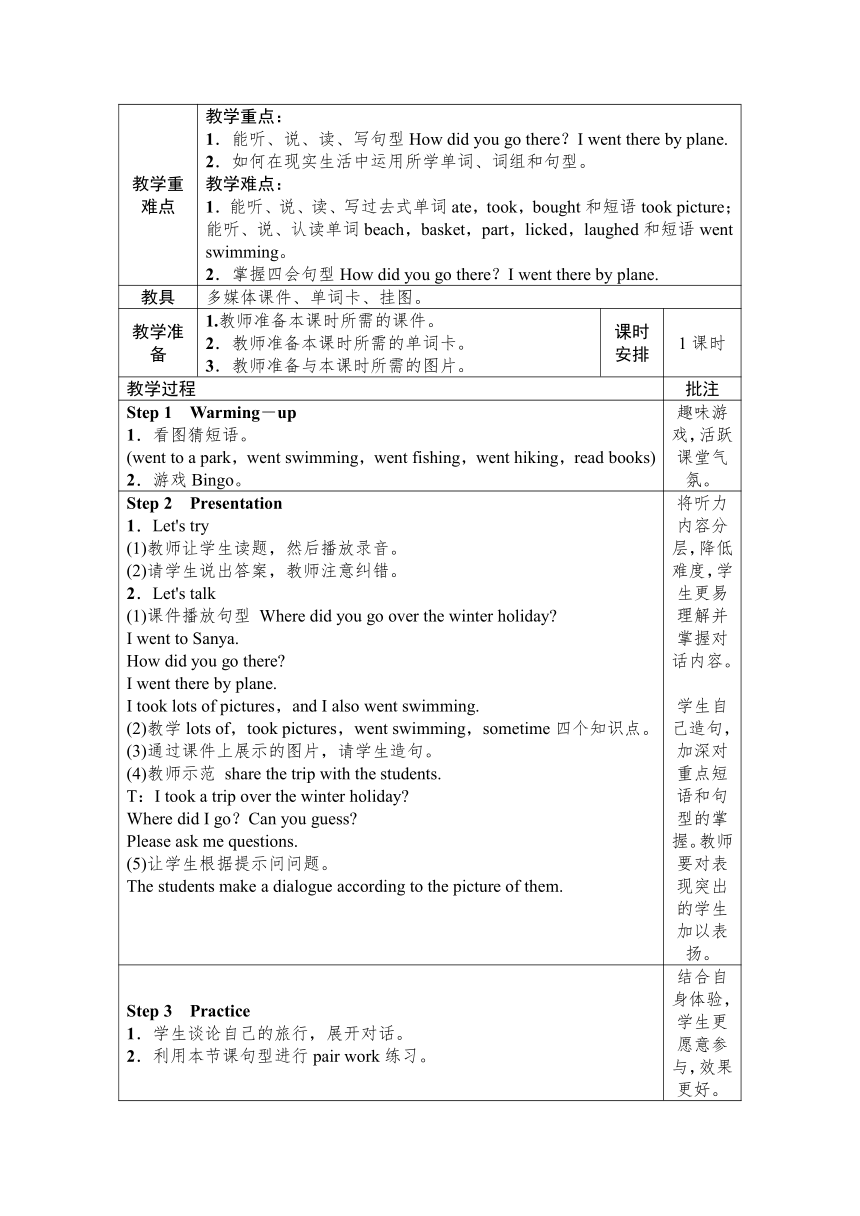
文档简介
Unit 3 Where did you go?
第一课时
教学内容
Part A Let's try & Let's talk
教学目标
1.能听懂Let's try并完成Tick or cross。
2.能理解Let's talk并能听、说、认读下列句子: What happened? Are you all right? I'm OK now. Where did you go? What did you do? It looks like a mule. Did you go to Turpan? Yes,we did.
3.能听、说、认读单词及词组:fell off,mule,could,till,Labour Day,Turpan。
4.能够问答有关假期去过的地方及做过的事情。
5.了解国内的一些名胜(如新疆)的风土人情。
教学重难点
1.掌握四会句型Where did you go over your holiday?I went to Mt.Tianshan,Xinjiang.并在实际情境中灵活运用。
2.能够听、说、读、写Where did you go over your holiday?I went to…等句型。
3.如何在现实生活中运用所学单词、词组和句型。
教具
多媒体课件、单词卡、挂图。
教学准备
1.教师准备本课时所需的课件。
2.教师准备本课时所需的挂图。
3.教师准备本课时所需要的单词卡。
课时安排
1课时
教学过程
批注
Step 1 Warming-up
1.T:Before class,let's warm up.Clap your hands and chant.
2.Free talk
T:I like holidays,because I can take a trip.Do you like holidays?Where did you go over your holiday?What did you do?
学生回答,并两人一组练习对话及表演对话。
3.Play a guessing game.
播放三幅图片,请学生猜测昨天做了什么:What did they do yesterday?
以师生互动游戏的方式回顾上个单元的重点知识,并导入新一单元的学习。对于在游戏环节表现优秀的同学,教师给予适当的奖励。
Step 2 Presentation
1.Let's try
T:I rode a bike yesterday.But suddenly what happened?(出示幻灯片) I fell off my bike and hurt my foot.
学习新句型:What happened?I fell off my bike and hurt my foot.
出示John的图片。
T:Do you want to know what happened to John?
Ss:Yes,I do.
(1)Listen and tick or cross.
(2)Check the answers.
(3)Change the cross answer into the tick answer.学习Let's talk。
由刚才的听力第三题,T:We know,John hurt his leg.His friend Amy was very worried,so she visited him.
2.Let's talk
教师说出指令:
(1)The first time,listen.
(2)The second time,let's watch the video.
(3)The third time,listen and repeat.Pay attention to the pronunciation of every word.
(4)The fourth time,listen and repeat again.Pay attention to the pronunciation and the intonation.
(5)Read by yourselves once,and then answer three questions.
a.What happened to John?
b.Where did John go?
c.What did John do?
3.Read and act
T:Class,who can read this dialogue?Other students can repeat.
T:Now read this part in pairs,and then ask two pairs to read.
T:Now read together.
创设情境,进行趣味游戏,活跃课堂气氛。
听之前要仔细看题,养成良好的做题习惯。
Step 3 Practice
1.T:Look at these verbs,can you change them into past form or original from?
(1)go (2)see (3)hurt (4)fall (5)did (6)came (7)could (8)happened
2.T:Look at these pictures,and choose the right answer.(看图片,选句子)
A.There are lots of grapes.
B.It looks like a tiger.
C.I fell off my bike.
D.We went to Turpan last Saturday.
E.Labour day.
F.He went fishing yesterday.
3.教师出示本市一些休闲旅游地区的图片,引导学生进行实际的交际运用。拓展重点句型Where did you go over you holiday?How did you go there?What did you do?然后以四人为单位分小组练习创编对话。小组内展示时,教师巡视,并适时引导点拨。
4.各组到讲台前面展示,拓展对话。教师及时评价。
分角色朗读和表演,教师可以对语音、语调掌握得较好的学生进行表扬,并且鼓励其他人向他学习。
板书设计
Unit 3 Where did you go?
What did you do last weekend?
Where did you go over your holiday?
What did you do?
作业设计
完成配套练习。
教学反思
第二课时
教学内容
Part A Let's learn & Listen,answer and write
教学目标
1.能听、说、读、写过去式单词went, rode,hurt和词组rode a horse,rode a bike,went camping,went fishing,hurt my foot;能正确使用动词过去式。
2.能掌握句型Where did you go? What did you do?及其正确的用法。
3.能利用What did you do? Where did you go?询问别人过去做的事情,并能运用于日常生活之中。
教学重难点
1.学习五个短语,注意ride,go,hurt的过去式。
2.能用句型进行简单的对话。
教具
多媒体课件、单词卡、挂图。
教学准备
1.教师准备本课时所需的课件。
2.教师准备本课时所需的单词卡。
3.教师准备本课时所需的挂图。
课时安排
1课时
教学过程
批注
Step 1 Warming-up
1.Free talk
2.做游戏:Guess,what's my favourite animal?让学生描述他们喜欢的动物,引导他们这么说:It's my favourite animal.It's…cm tall.Its tail is…cm long It likes to eat… It can…Guess,what's this?
趣味游戏,活跃课堂气氛。
Step 2 Presentation
1.呈现新单词
(1)围绕图片内容,教师提问:Where did you go last Saturday?What did you do there?学生与老师一起讨论John上周末的活动:He rode a bike.He hurt his foot.利用单词卡教词组:rode a bike,rode a horse,went camping,went fishing,hurt my foot。注意rode和a 之间的连读。
(2)教师在课件上出示词组图片。
2.Let's learn
(1)教师播放Let's learn课文动画,学生跟读。
(2)学生同桌合作,模仿Let's learn中的对话,根据实际情况编写对话。
(3)学生在小组内练习:Where did you go last Saturday?What did you do there?。操练本课时的单词和句型。
(4)教师请几个小组展示。
(5)学生两人一组,轮流抽取卡片编对话。
S1:Where did you go last Saturday?
S2:I rode a bike.What about you?
S1:I went fishing.
(6)快速抢答。
规则:全班学生分成两大组,请一名学生上来抽取两张卡片并一次做出相应的动作,两个组的学生根据表演者的动作猜词:He…and…猜对的小组得一分,最后分数高的小组获胜。
创设情境,进行趣味游戏,活跃课堂气氛。
Step 3 Practice
1.完成Listen,answer and write的听力任务。
2.学生汇报
主动举手汇报你在上一学习环节中的收获。
(1)我会读这些词组了。
(2)我知道这些词组的意思了。(这两步可找你的小伙伴跟你一起来完成这个任务)
(3)我知道这些过去时词组的原形了。
rode a horse—ride a horse went camping—go camping
went fishing—go fishing rode a bike—ride a bike
hurt my foot—hurt my foot
(4)我发现了一个很有趣的问题,hurt这个词的原形和过去式形式是一样的,我就可以这样来记:虽然你受伤了,但物质本身没有变,所以原形和过去式形式是一样的。(同学们,这个是老师记忆的方法哦,你们有什么别的办法,说出来我们一起分享吧)
(5)我可以用刚才学的词组和句子跟我的小伙伴对话了。比如:
Where did you go last weekend?
I went to Yue Liang Wan Park.
What did you do there?
I rode a horse and hurt my foot.
(6)你还有什么与众不同的主意和想法吗?来大声的告诉我们吧!
通过学生们的自我反思和结对互助练习,逐渐掌握句型。通过上台表演,鼓励学生大胆表达。
板书设计
Unit 3 Where did you go?
rode a horse rode a bike went camping
hurt my foot went fishing
作业设计
1.抄写本课时的四会单词3遍。
2.和他人谈一谈自己上个周末的活动。
教学反思
第三课时
教学内容
Part B Let's try & Let's talk
教学目标
1.学生能够在教师的帮助下,借助图片,理解对话大意,并能回答对话下面的问题:Where did Amy go last winter holiday? How did she go there? What did she do?
2.能够在语境中理解生词beach的意思,并能正确发音;能通过对话了解海南三亚的海岛风光;能够用正确的语音、语调朗读对话,并进行角色表演;能够听、说、读、写,并能在情境中恰当运用以下句型Where did you go?Did you…?Yes,we did./No,we didn't.How did you go there?What did you do?谈论假期活动;能够在情景中恰当运用由where、what和how引导的一般过去时的特殊疑问句。
教学重难点
教学重点:
1.能听、说、读、写句型How did you go there?I went there by plane.
2.如何在现实生活中运用所学单词、词组和句型。
教学难点:
1.能听、说、读、写过去式单词ate,took,bought和短语took picture;能听、说、认读单词beach,basket,part,licked,laughed和短语went swimming。
2.掌握四会句型How did you go there?I went there by plane.
教具
多媒体课件、单词卡、挂图。
教学准备
1.教师准备本课时所需的课件。
2.教师准备本课时所需的单词卡。
3.教师准备与本课时所需的图片。
课时安排
1课时
教学过程
批注
Step 1 Warming-up
1.看图猜短语。
(went to a park,went swimming,went fishing,went hiking,read books)
2.游戏Bingo。
趣味游戏,活跃课堂气氛。
Step 2 Presentation
1.Let's try
(1)教师让学生读题,然后播放录音。
(2)请学生说出答案,教师注意纠错。
2.Let's talk
(1)课件播放句型 Where did you go over the winter holiday?
I went to Sanya.
How did you go there?
I went there by plane.
I took lots of pictures,and I also went swimming.
(2)教学lots of,took pictures,went swimming,sometime四个知识点。
(3)通过课件上展示的图片,请学生造句。
(4)教师示范 share the trip with the students.
T:I took a trip over the winter holiday?
Where did I go?Can you guess?
Please ask me questions.
(5)让学生根据提示问问题。
The students make a dialogue according to the picture of them.
将听力内容分层,降低难度,学生更易理解并掌握对话内容。
学生自己造句,加深对重点短语和句型的掌握。教师要对表现突出的学生加以表扬。
Step 3 Practice
1.学生谈论自己的旅行,展开对话。
2.利用本节课句型进行pair work练习。
结合自身体验,学生更愿意参与,效果更好。
板书设计
Unit 3 Where did you go?
beach sometime
lots of=a lot of took pictures
How was the weather in Sanya?
Where did you go over the winter holiday?
作业设计
1.朗读对话。
2.用词组或短句来描述自己的爸爸或妈妈上周末的活动情况,并且写下来。
教学反思
第四课时
教学内容
Part B Let's learn & Look and say
教学目标
1.能听、说、读、写过去式单词ate,took和短语bought gift,took picture等。
2.能运用句子How was your summer holiday? What did you do there?对别人在假期里所做的事情展开问答。
教学重难点
1.能听、说、读、写过去式单词ate,took和短语bought gift,took picture等。
2.能运用句子How was your summer holiday? What did you do there?对别人在假期里所做的事情展开问答。
3.掌握四个动词短语的过去式的读音和拼写以及灵活运用句型What did you do over your holiday?
4.在现实生活中运用所学单词、词组和句型。
教具
多媒体课件、单词卡、一些照片。
教学准备
1.教师准备本课时所需的课件。
2.教师准备本课时所需的单词卡。
3.教师准备与本课时内容有关的照片。
课时安排
1课时
教学过程
批注
Step 1 Warming-up
1.教师播放歌曲《Tell me about your holiday》,带领学生一起哼唱。
2.用地图让学生找Ningbo Zoo导入。
趣味游戏,活跃课堂气氛。
Step 2 Presentation
Let's learn
1.用上周末是清明假期引出学生都去了哪里,跟谁去的,做了什么。(与生活相联系,用实际话题引导学生,让学生有话可说,复习了where did…,what did…句型,让学生滚动练习所学知识)
T:Last weekend was the Tomb-sweeping Day,so we had a Three-day holiday.
Who did you go with?What did you do there?Where did you go?
S:I went…
2.用学生愉快的假期引出老师的假期,从而教授本课时新词和句型。
T:I think all of you had a good holiday.Do you want to know something about my holiday?
Ss:Yes.Where did you go?
(guess)
T:I visited a place.There're lots of animals.Where did I go?
T:Yes,I visited Ningbo Younger Zoo.
T:How far is it from Xinchang to Ningbo?
Ss:…
T:So I drove a car to get there.It took me almost 1 hour.
(1)教授took pictures
T:Look! We're here.I visited the zoo with my family.And I took many pictures.
T:What did I do?
Ss:You took pictures.
(出示句型What did…do?)
(2)教授bought gifts
(从照片欣赏引到我的女儿要买礼物给她的弟弟)
T:In front of the zoo,there're lots of gifts…What did the girl want?
Ss:She wanted the monkey.
T:Yes,she wanted to buy some gifts for her younger brother.
bought gifts buy-bought
T:What did the girl do?
Ss:She bought gifts.
(3)教授went swimming
T:You know,on that day,in the afternoon,it was very hot,so I went swimming.
(跟读多次,注意went的发音)
T:What did I do?
Ss:You went swimming.
T:Can you swim?
T:Do you like swimming?
T:I like swimming,too.It's good for my health.We should do more exercise every day to keep healthy and make ourselves stronger!
(4)教授 ate fresh food
T:But on that day,the most exciting moment was the big dinner(课件展现美味海鲜).We ate fresh sea food.How delicious!
ate fresh food(跟读多次) eat—ate
T:What did we do?
Ss:You ate fresh food.
T:Good! Miss Dong always eats fresh food,so I'm healthy.You should eat fresh food,and keep healthy.
3.总结所学的四个短语,引出本课时句型How was…holiday?
T:This is my holiday.What did I do?
Ss:You took pictures.
Ss:…
T:How was my holiday?
Ss:It was…
4.总结不规则动词过去式
通过复习以前所学知识导入新知识,学生容易接受。
猜谜游戏,引发学生的好奇心和求知欲,让课堂充满乐趣。
在呈现新短语的过程中,对于学生表达不到位的地方,教师注意及时给予指导和帮助。
Step 3 Practice
1.通过Look and say 操练所学词组。
2.小组操练对话。
A:How was your summer holiday?
B:It was good.I went swimming and took lots of pictures.
3.在问答过程中完成书中所示的表格。
4.邀请几组同学到前面汇报调查结果。
趣味游戏,寓教于乐。
板书设计
Unit 3 Where did you go?
ate fresh food went swimming took pictures bought gifts
How was your…holiday?
作业设计
听本部分的录音,读给朋友或家长听。
教学反思
第五课时
教学内容
Part B Read and write
教学目标
1.能读懂并理解Read and write的内容,并完成其中的任务。
2.学生能够通过看图讨论、预测故事的开端和进一步发展来激活相关背景知识或储备词汇。
3.能够通过完成读后活动训练在语篇中捕捉不同类型信息的能力和思考能力。
4.能够在阅读中获取有用的句型口头描述一下自己一天的活动。
教学重难点
1.读懂日记,了解吴一凡的虽糟糕但又美好的一天,懂得事情都有两面性,好事坏事没有绝对,可以互相转换,因此要保持乐观的心态。
2.掌握lick,laugh,dress up,play the part of等新单词和词组过去式的发音与意思。
教具
多媒体课件、单词卡。
教学准备
1.教师准备本课时所需的课件。
2.教师准备本课时所需的单词卡。
课时安排
1课时
教学过程
批注
Step 1 Warming-up
1.Greetings
T:Hello!I'm Miss Huang.Nice to meet you!
Ss:Nice to meet you,too.
T:How are you today?
Ss:Fine,thank you.
2.Let's say
复习一些动词的过去式,教师说原形,学生说出其过去式形式。
3.Say more
将上一环节中所复习的动词过去式留下几组,让学生进行拓词。例如:hurt—hurt my leg,had—had an English class等。
通过复习以前所学知识导入新知识,学生容易接受。
Step 2 Presentation
Read and write
1.阅读前:
(1)看一看,说一说。教师要求学生按教材要求与同桌讨论:How did Wu Yifan meet Max? What will happen next?完成后可在全班交流,教师把学生们的想法用简单的句子板书在黑板上。
(2)教师让学生分类哪些是好的事情,哪些是坏的事情,从而引出主题:life is full of good news and bad news。
2.阅读中:
(1)第一次阅读:教师要求学生尝试快速阅读文本,捕捉关键信息,给图片排序。
(2)第二次阅读:教师要求学生再次阅读文本,概括并写出这一天发生在吴一凡一家的三件好事和两件坏事。
(3)第三次阅读:理解更多细节。
(4)教师播放课件,呈现几名学生讲述自己同时经历好事情和坏事情的不寻常的经历。
(5)教师引导学生结合自己的实际情况,写出发生在自己身上的一件好事情和一件坏事情以及自己的对策。
3.阅读后:
(1)教师补充中国传统故事《塞翁失马,焉知非福》。
(2)让学生在文中用横线画出含有过去式的词组,师生一起梳理文章关键信息,完成表格。
让学生通过对比,先自己找找同一天发生在自己身上的好事和坏事。对于学生表达不到位的地方,教师注意及时给予指导和帮助。
Step 3 Practice
1.同桌两人仔细阅读,捕捉关键信息, 任选其中2个问题,进行一问一答,限时两分钟。然后教师进行Let's check。
(1)在核对答案的时候,出现dressed up词组时,呈现一个男孩装扮前后的两张图片。
(2)Robin played the part of a dog.通过这个句子引出play the part of,让学生借助图片,选出短语play the part of的中文意思是“参与”还是“扮演”。然后通过播放一个funny play,操练短语play the part of。
2.再次小声读全文,画出所有事件。
(1)学生找出所有吴一凡在一天的早上和下午做的事。
(2)教师示范将上午和下午的一件事情区分为好消息和坏消息,让学生打开书本做书本后面的习题。
趣味游戏,寓教于乐。
板书设计
Unit 3 Where did you go?
rode a bike took pictures
bought some gifts ate some delicious food
stayed in the hotel dressed up made a funny play
Mum ate some bad fruit and didn't feel well.
作业设计
1.抄写四会词3遍。
2.课后继续交流同桌的周末或前天的活动信息。
教学反思
第六课时
教学内容
Part B Let's check & Let's wrap it up & Part C Story time
教学目标
1.能够完成Let's check。
2.能理解Story time中的故事。
教学重难点
1.能够完成Let's check。
2.能理解Story time中的故事。
教具
课件、单词卡。
教学准备
1.教师准备本课时所需的课件。
2.教师准备本课时所需的单词卡。
课时安排
1课时
教学过程
批注
Step 1 Warming-up
1.利用单词卡,帮助学生复习各个词汇。(动词及其过去式)
2.Free talk
教师先和基础较好的学生示范,然后让学生合作完成。例如:
(1)How was your summer holiday?It was good./…
(2)Where did you go over your holiday?I went to…
(3)How did you go there?I went there by…
(4)What did you do there?I…
(5)When did you go there?I went there…
(6)Who did you go with?I went with…
主要复习本单元的主句型。
通过复习以前所学知识导入新知识,学生容易接受。
Step 2 Presentation
1.Let's check
(1)在听录音之前,学生逐一看图,尝试推测图片表达的意思和听力要求。
(2)教师播放本部分录音,学生根据录音内容完成听力判断练习。
(3)师生一起核对答案。
2.Let's wrap it up
(1)自主预习:学生尝试完成Let's wrap it up中的任务。
(2)教师在多媒体课件中呈现一些不规则动词的原形和过去式,让学生进行匹配。
(3)师生核对答案,学生朗读并熟记。
3.Story time
(1)小组合作学习。学生试读故事,画出不懂的地方,然后小组合作讨论,相互答疑解难。
(2)教师通过视频和图片,引出unusual trip这一话题。
(3)教师播放Story time板块的动画,学生听一遍,了解故事梗概。回答问题:Where did Zoom go?
(4)学生自读Story time两遍,在此过程中向小伙伴或老师寻求帮助,理解believe,moon,spaceship和dream, 然后回答问题:
a.How was Zoom's holiday?
b.Where did Zoom go?
c.What did Zoom see?
师生一起核对答案。
(5)教师播放Story time的录音,学生反复跟读,模仿语音语调,感受故事情境。请一位英语基础较好的学生和自己搭档,示范朗读故事。然后让学生以小组为单位分角色朗读课文。
核对答案时,对于难拼写的单词,教师要板书。对于问答题,教师要引导和帮助学生书写完整的英文句子。
Step 3 Practice
1.复述对话
在此环节中,教师要帮助学生找出key words以降低难度。同时,要教给学生如何找关键词。
2.请学生分角色读或表演Story time的小故事。
跟读故事,再次复习本单元重点句型。
板书设计
Unit 3 Where did you go?
It's time to go.
Good! Here comes a spaceship.
It was a dream.
How did you go there?
Did you take any pictures?
作业设计
1.学生听录音,跟读对话,书写四会句型。
2.利用所学的知识调查朋友的有关活动信息,并记录下来。
教学反思
第一课时
教学内容
Part A Let's try & Let's talk
教学目标
1.能听懂Let's try并完成Tick or cross。
2.能理解Let's talk并能听、说、认读下列句子: What happened? Are you all right? I'm OK now. Where did you go? What did you do? It looks like a mule. Did you go to Turpan? Yes,we did.
3.能听、说、认读单词及词组:fell off,mule,could,till,Labour Day,Turpan。
4.能够问答有关假期去过的地方及做过的事情。
5.了解国内的一些名胜(如新疆)的风土人情。
教学重难点
1.掌握四会句型Where did you go over your holiday?I went to Mt.Tianshan,Xinjiang.并在实际情境中灵活运用。
2.能够听、说、读、写Where did you go over your holiday?I went to…等句型。
3.如何在现实生活中运用所学单词、词组和句型。
教具
多媒体课件、单词卡、挂图。
教学准备
1.教师准备本课时所需的课件。
2.教师准备本课时所需的挂图。
3.教师准备本课时所需要的单词卡。
课时安排
1课时
教学过程
批注
Step 1 Warming-up
1.T:Before class,let's warm up.Clap your hands and chant.
2.Free talk
T:I like holidays,because I can take a trip.Do you like holidays?Where did you go over your holiday?What did you do?
学生回答,并两人一组练习对话及表演对话。
3.Play a guessing game.
播放三幅图片,请学生猜测昨天做了什么:What did they do yesterday?
以师生互动游戏的方式回顾上个单元的重点知识,并导入新一单元的学习。对于在游戏环节表现优秀的同学,教师给予适当的奖励。
Step 2 Presentation
1.Let's try
T:I rode a bike yesterday.But suddenly what happened?(出示幻灯片) I fell off my bike and hurt my foot.
学习新句型:What happened?I fell off my bike and hurt my foot.
出示John的图片。
T:Do you want to know what happened to John?
Ss:Yes,I do.
(1)Listen and tick or cross.
(2)Check the answers.
(3)Change the cross answer into the tick answer.学习Let's talk。
由刚才的听力第三题,T:We know,John hurt his leg.His friend Amy was very worried,so she visited him.
2.Let's talk
教师说出指令:
(1)The first time,listen.
(2)The second time,let's watch the video.
(3)The third time,listen and repeat.Pay attention to the pronunciation of every word.
(4)The fourth time,listen and repeat again.Pay attention to the pronunciation and the intonation.
(5)Read by yourselves once,and then answer three questions.
a.What happened to John?
b.Where did John go?
c.What did John do?
3.Read and act
T:Class,who can read this dialogue?Other students can repeat.
T:Now read this part in pairs,and then ask two pairs to read.
T:Now read together.
创设情境,进行趣味游戏,活跃课堂气氛。
听之前要仔细看题,养成良好的做题习惯。
Step 3 Practice
1.T:Look at these verbs,can you change them into past form or original from?
(1)go (2)see (3)hurt (4)fall (5)did (6)came (7)could (8)happened
2.T:Look at these pictures,and choose the right answer.(看图片,选句子)
A.There are lots of grapes.
B.It looks like a tiger.
C.I fell off my bike.
D.We went to Turpan last Saturday.
E.Labour day.
F.He went fishing yesterday.
3.教师出示本市一些休闲旅游地区的图片,引导学生进行实际的交际运用。拓展重点句型Where did you go over you holiday?How did you go there?What did you do?然后以四人为单位分小组练习创编对话。小组内展示时,教师巡视,并适时引导点拨。
4.各组到讲台前面展示,拓展对话。教师及时评价。
分角色朗读和表演,教师可以对语音、语调掌握得较好的学生进行表扬,并且鼓励其他人向他学习。
板书设计
Unit 3 Where did you go?
What did you do last weekend?
Where did you go over your holiday?
What did you do?
作业设计
完成配套练习。
教学反思
第二课时
教学内容
Part A Let's learn & Listen,answer and write
教学目标
1.能听、说、读、写过去式单词went, rode,hurt和词组rode a horse,rode a bike,went camping,went fishing,hurt my foot;能正确使用动词过去式。
2.能掌握句型Where did you go? What did you do?及其正确的用法。
3.能利用What did you do? Where did you go?询问别人过去做的事情,并能运用于日常生活之中。
教学重难点
1.学习五个短语,注意ride,go,hurt的过去式。
2.能用句型进行简单的对话。
教具
多媒体课件、单词卡、挂图。
教学准备
1.教师准备本课时所需的课件。
2.教师准备本课时所需的单词卡。
3.教师准备本课时所需的挂图。
课时安排
1课时
教学过程
批注
Step 1 Warming-up
1.Free talk
2.做游戏:Guess,what's my favourite animal?让学生描述他们喜欢的动物,引导他们这么说:It's my favourite animal.It's…cm tall.Its tail is…cm long It likes to eat… It can…Guess,what's this?
趣味游戏,活跃课堂气氛。
Step 2 Presentation
1.呈现新单词
(1)围绕图片内容,教师提问:Where did you go last Saturday?What did you do there?学生与老师一起讨论John上周末的活动:He rode a bike.He hurt his foot.利用单词卡教词组:rode a bike,rode a horse,went camping,went fishing,hurt my foot。注意rode和a 之间的连读。
(2)教师在课件上出示词组图片。
2.Let's learn
(1)教师播放Let's learn课文动画,学生跟读。
(2)学生同桌合作,模仿Let's learn中的对话,根据实际情况编写对话。
(3)学生在小组内练习:Where did you go last Saturday?What did you do there?。操练本课时的单词和句型。
(4)教师请几个小组展示。
(5)学生两人一组,轮流抽取卡片编对话。
S1:Where did you go last Saturday?
S2:I rode a bike.What about you?
S1:I went fishing.
(6)快速抢答。
规则:全班学生分成两大组,请一名学生上来抽取两张卡片并一次做出相应的动作,两个组的学生根据表演者的动作猜词:He…and…猜对的小组得一分,最后分数高的小组获胜。
创设情境,进行趣味游戏,活跃课堂气氛。
Step 3 Practice
1.完成Listen,answer and write的听力任务。
2.学生汇报
主动举手汇报你在上一学习环节中的收获。
(1)我会读这些词组了。
(2)我知道这些词组的意思了。(这两步可找你的小伙伴跟你一起来完成这个任务)
(3)我知道这些过去时词组的原形了。
rode a horse—ride a horse went camping—go camping
went fishing—go fishing rode a bike—ride a bike
hurt my foot—hurt my foot
(4)我发现了一个很有趣的问题,hurt这个词的原形和过去式形式是一样的,我就可以这样来记:虽然你受伤了,但物质本身没有变,所以原形和过去式形式是一样的。(同学们,这个是老师记忆的方法哦,你们有什么别的办法,说出来我们一起分享吧)
(5)我可以用刚才学的词组和句子跟我的小伙伴对话了。比如:
Where did you go last weekend?
I went to Yue Liang Wan Park.
What did you do there?
I rode a horse and hurt my foot.
(6)你还有什么与众不同的主意和想法吗?来大声的告诉我们吧!
通过学生们的自我反思和结对互助练习,逐渐掌握句型。通过上台表演,鼓励学生大胆表达。
板书设计
Unit 3 Where did you go?
rode a horse rode a bike went camping
hurt my foot went fishing
作业设计
1.抄写本课时的四会单词3遍。
2.和他人谈一谈自己上个周末的活动。
教学反思
第三课时
教学内容
Part B Let's try & Let's talk
教学目标
1.学生能够在教师的帮助下,借助图片,理解对话大意,并能回答对话下面的问题:Where did Amy go last winter holiday? How did she go there? What did she do?
2.能够在语境中理解生词beach的意思,并能正确发音;能通过对话了解海南三亚的海岛风光;能够用正确的语音、语调朗读对话,并进行角色表演;能够听、说、读、写,并能在情境中恰当运用以下句型Where did you go?Did you…?Yes,we did./No,we didn't.How did you go there?What did you do?谈论假期活动;能够在情景中恰当运用由where、what和how引导的一般过去时的特殊疑问句。
教学重难点
教学重点:
1.能听、说、读、写句型How did you go there?I went there by plane.
2.如何在现实生活中运用所学单词、词组和句型。
教学难点:
1.能听、说、读、写过去式单词ate,took,bought和短语took picture;能听、说、认读单词beach,basket,part,licked,laughed和短语went swimming。
2.掌握四会句型How did you go there?I went there by plane.
教具
多媒体课件、单词卡、挂图。
教学准备
1.教师准备本课时所需的课件。
2.教师准备本课时所需的单词卡。
3.教师准备与本课时所需的图片。
课时安排
1课时
教学过程
批注
Step 1 Warming-up
1.看图猜短语。
(went to a park,went swimming,went fishing,went hiking,read books)
2.游戏Bingo。
趣味游戏,活跃课堂气氛。
Step 2 Presentation
1.Let's try
(1)教师让学生读题,然后播放录音。
(2)请学生说出答案,教师注意纠错。
2.Let's talk
(1)课件播放句型 Where did you go over the winter holiday?
I went to Sanya.
How did you go there?
I went there by plane.
I took lots of pictures,and I also went swimming.
(2)教学lots of,took pictures,went swimming,sometime四个知识点。
(3)通过课件上展示的图片,请学生造句。
(4)教师示范 share the trip with the students.
T:I took a trip over the winter holiday?
Where did I go?Can you guess?
Please ask me questions.
(5)让学生根据提示问问题。
The students make a dialogue according to the picture of them.
将听力内容分层,降低难度,学生更易理解并掌握对话内容。
学生自己造句,加深对重点短语和句型的掌握。教师要对表现突出的学生加以表扬。
Step 3 Practice
1.学生谈论自己的旅行,展开对话。
2.利用本节课句型进行pair work练习。
结合自身体验,学生更愿意参与,效果更好。
板书设计
Unit 3 Where did you go?
beach sometime
lots of=a lot of took pictures
How was the weather in Sanya?
Where did you go over the winter holiday?
作业设计
1.朗读对话。
2.用词组或短句来描述自己的爸爸或妈妈上周末的活动情况,并且写下来。
教学反思
第四课时
教学内容
Part B Let's learn & Look and say
教学目标
1.能听、说、读、写过去式单词ate,took和短语bought gift,took picture等。
2.能运用句子How was your summer holiday? What did you do there?对别人在假期里所做的事情展开问答。
教学重难点
1.能听、说、读、写过去式单词ate,took和短语bought gift,took picture等。
2.能运用句子How was your summer holiday? What did you do there?对别人在假期里所做的事情展开问答。
3.掌握四个动词短语的过去式的读音和拼写以及灵活运用句型What did you do over your holiday?
4.在现实生活中运用所学单词、词组和句型。
教具
多媒体课件、单词卡、一些照片。
教学准备
1.教师准备本课时所需的课件。
2.教师准备本课时所需的单词卡。
3.教师准备与本课时内容有关的照片。
课时安排
1课时
教学过程
批注
Step 1 Warming-up
1.教师播放歌曲《Tell me about your holiday》,带领学生一起哼唱。
2.用地图让学生找Ningbo Zoo导入。
趣味游戏,活跃课堂气氛。
Step 2 Presentation
Let's learn
1.用上周末是清明假期引出学生都去了哪里,跟谁去的,做了什么。(与生活相联系,用实际话题引导学生,让学生有话可说,复习了where did…,what did…句型,让学生滚动练习所学知识)
T:Last weekend was the Tomb-sweeping Day,so we had a Three-day holiday.
Who did you go with?What did you do there?Where did you go?
S:I went…
2.用学生愉快的假期引出老师的假期,从而教授本课时新词和句型。
T:I think all of you had a good holiday.Do you want to know something about my holiday?
Ss:Yes.Where did you go?
(guess)
T:I visited a place.There're lots of animals.Where did I go?
T:Yes,I visited Ningbo Younger Zoo.
T:How far is it from Xinchang to Ningbo?
Ss:…
T:So I drove a car to get there.It took me almost 1 hour.
(1)教授took pictures
T:Look! We're here.I visited the zoo with my family.And I took many pictures.
T:What did I do?
Ss:You took pictures.
(出示句型What did…do?)
(2)教授bought gifts
(从照片欣赏引到我的女儿要买礼物给她的弟弟)
T:In front of the zoo,there're lots of gifts…What did the girl want?
Ss:She wanted the monkey.
T:Yes,she wanted to buy some gifts for her younger brother.
bought gifts buy-bought
T:What did the girl do?
Ss:She bought gifts.
(3)教授went swimming
T:You know,on that day,in the afternoon,it was very hot,so I went swimming.
(跟读多次,注意went的发音)
T:What did I do?
Ss:You went swimming.
T:Can you swim?
T:Do you like swimming?
T:I like swimming,too.It's good for my health.We should do more exercise every day to keep healthy and make ourselves stronger!
(4)教授 ate fresh food
T:But on that day,the most exciting moment was the big dinner(课件展现美味海鲜).We ate fresh sea food.How delicious!
ate fresh food(跟读多次) eat—ate
T:What did we do?
Ss:You ate fresh food.
T:Good! Miss Dong always eats fresh food,so I'm healthy.You should eat fresh food,and keep healthy.
3.总结所学的四个短语,引出本课时句型How was…holiday?
T:This is my holiday.What did I do?
Ss:You took pictures.
Ss:…
T:How was my holiday?
Ss:It was…
4.总结不规则动词过去式
通过复习以前所学知识导入新知识,学生容易接受。
猜谜游戏,引发学生的好奇心和求知欲,让课堂充满乐趣。
在呈现新短语的过程中,对于学生表达不到位的地方,教师注意及时给予指导和帮助。
Step 3 Practice
1.通过Look and say 操练所学词组。
2.小组操练对话。
A:How was your summer holiday?
B:It was good.I went swimming and took lots of pictures.
3.在问答过程中完成书中所示的表格。
4.邀请几组同学到前面汇报调查结果。
趣味游戏,寓教于乐。
板书设计
Unit 3 Where did you go?
ate fresh food went swimming took pictures bought gifts
How was your…holiday?
作业设计
听本部分的录音,读给朋友或家长听。
教学反思
第五课时
教学内容
Part B Read and write
教学目标
1.能读懂并理解Read and write的内容,并完成其中的任务。
2.学生能够通过看图讨论、预测故事的开端和进一步发展来激活相关背景知识或储备词汇。
3.能够通过完成读后活动训练在语篇中捕捉不同类型信息的能力和思考能力。
4.能够在阅读中获取有用的句型口头描述一下自己一天的活动。
教学重难点
1.读懂日记,了解吴一凡的虽糟糕但又美好的一天,懂得事情都有两面性,好事坏事没有绝对,可以互相转换,因此要保持乐观的心态。
2.掌握lick,laugh,dress up,play the part of等新单词和词组过去式的发音与意思。
教具
多媒体课件、单词卡。
教学准备
1.教师准备本课时所需的课件。
2.教师准备本课时所需的单词卡。
课时安排
1课时
教学过程
批注
Step 1 Warming-up
1.Greetings
T:Hello!I'm Miss Huang.Nice to meet you!
Ss:Nice to meet you,too.
T:How are you today?
Ss:Fine,thank you.
2.Let's say
复习一些动词的过去式,教师说原形,学生说出其过去式形式。
3.Say more
将上一环节中所复习的动词过去式留下几组,让学生进行拓词。例如:hurt—hurt my leg,had—had an English class等。
通过复习以前所学知识导入新知识,学生容易接受。
Step 2 Presentation
Read and write
1.阅读前:
(1)看一看,说一说。教师要求学生按教材要求与同桌讨论:How did Wu Yifan meet Max? What will happen next?完成后可在全班交流,教师把学生们的想法用简单的句子板书在黑板上。
(2)教师让学生分类哪些是好的事情,哪些是坏的事情,从而引出主题:life is full of good news and bad news。
2.阅读中:
(1)第一次阅读:教师要求学生尝试快速阅读文本,捕捉关键信息,给图片排序。
(2)第二次阅读:教师要求学生再次阅读文本,概括并写出这一天发生在吴一凡一家的三件好事和两件坏事。
(3)第三次阅读:理解更多细节。
(4)教师播放课件,呈现几名学生讲述自己同时经历好事情和坏事情的不寻常的经历。
(5)教师引导学生结合自己的实际情况,写出发生在自己身上的一件好事情和一件坏事情以及自己的对策。
3.阅读后:
(1)教师补充中国传统故事《塞翁失马,焉知非福》。
(2)让学生在文中用横线画出含有过去式的词组,师生一起梳理文章关键信息,完成表格。
让学生通过对比,先自己找找同一天发生在自己身上的好事和坏事。对于学生表达不到位的地方,教师注意及时给予指导和帮助。
Step 3 Practice
1.同桌两人仔细阅读,捕捉关键信息, 任选其中2个问题,进行一问一答,限时两分钟。然后教师进行Let's check。
(1)在核对答案的时候,出现dressed up词组时,呈现一个男孩装扮前后的两张图片。
(2)Robin played the part of a dog.通过这个句子引出play the part of,让学生借助图片,选出短语play the part of的中文意思是“参与”还是“扮演”。然后通过播放一个funny play,操练短语play the part of。
2.再次小声读全文,画出所有事件。
(1)学生找出所有吴一凡在一天的早上和下午做的事。
(2)教师示范将上午和下午的一件事情区分为好消息和坏消息,让学生打开书本做书本后面的习题。
趣味游戏,寓教于乐。
板书设计
Unit 3 Where did you go?
rode a bike took pictures
bought some gifts ate some delicious food
stayed in the hotel dressed up made a funny play
Mum ate some bad fruit and didn't feel well.
作业设计
1.抄写四会词3遍。
2.课后继续交流同桌的周末或前天的活动信息。
教学反思
第六课时
教学内容
Part B Let's check & Let's wrap it up & Part C Story time
教学目标
1.能够完成Let's check。
2.能理解Story time中的故事。
教学重难点
1.能够完成Let's check。
2.能理解Story time中的故事。
教具
课件、单词卡。
教学准备
1.教师准备本课时所需的课件。
2.教师准备本课时所需的单词卡。
课时安排
1课时
教学过程
批注
Step 1 Warming-up
1.利用单词卡,帮助学生复习各个词汇。(动词及其过去式)
2.Free talk
教师先和基础较好的学生示范,然后让学生合作完成。例如:
(1)How was your summer holiday?It was good./…
(2)Where did you go over your holiday?I went to…
(3)How did you go there?I went there by…
(4)What did you do there?I…
(5)When did you go there?I went there…
(6)Who did you go with?I went with…
主要复习本单元的主句型。
通过复习以前所学知识导入新知识,学生容易接受。
Step 2 Presentation
1.Let's check
(1)在听录音之前,学生逐一看图,尝试推测图片表达的意思和听力要求。
(2)教师播放本部分录音,学生根据录音内容完成听力判断练习。
(3)师生一起核对答案。
2.Let's wrap it up
(1)自主预习:学生尝试完成Let's wrap it up中的任务。
(2)教师在多媒体课件中呈现一些不规则动词的原形和过去式,让学生进行匹配。
(3)师生核对答案,学生朗读并熟记。
3.Story time
(1)小组合作学习。学生试读故事,画出不懂的地方,然后小组合作讨论,相互答疑解难。
(2)教师通过视频和图片,引出unusual trip这一话题。
(3)教师播放Story time板块的动画,学生听一遍,了解故事梗概。回答问题:Where did Zoom go?
(4)学生自读Story time两遍,在此过程中向小伙伴或老师寻求帮助,理解believe,moon,spaceship和dream, 然后回答问题:
a.How was Zoom's holiday?
b.Where did Zoom go?
c.What did Zoom see?
师生一起核对答案。
(5)教师播放Story time的录音,学生反复跟读,模仿语音语调,感受故事情境。请一位英语基础较好的学生和自己搭档,示范朗读故事。然后让学生以小组为单位分角色朗读课文。
核对答案时,对于难拼写的单词,教师要板书。对于问答题,教师要引导和帮助学生书写完整的英文句子。
Step 3 Practice
1.复述对话
在此环节中,教师要帮助学生找出key words以降低难度。同时,要教给学生如何找关键词。
2.请学生分角色读或表演Story time的小故事。
跟读故事,再次复习本单元重点句型。
板书设计
Unit 3 Where did you go?
It's time to go.
Good! Here comes a spaceship.
It was a dream.
How did you go there?
Did you take any pictures?
作业设计
1.学生听录音,跟读对话,书写四会句型。
2.利用所学的知识调查朋友的有关活动信息,并记录下来。
教学反思
